JAGUAR XJ 2004 X350 / 3.G Owners Manual
Manufacturer: JAGUAR, Model Year: 2004, Model line: XJ, Model: JAGUAR XJ 2004 X350 / 3.GPages: 227, PDF Size: 4.22 MB
Page 191 of 227
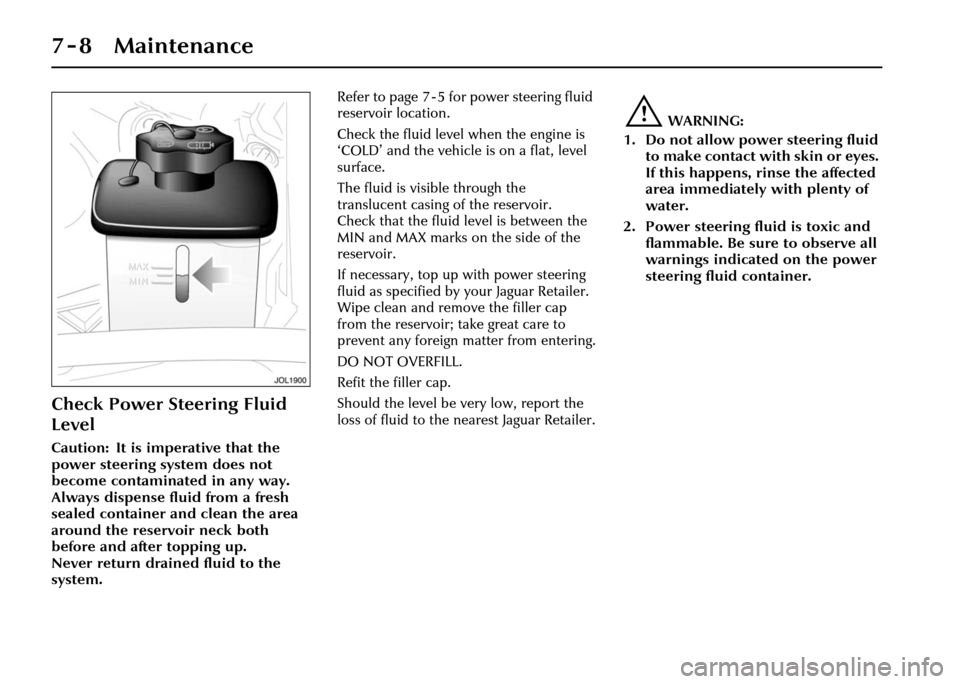
7 - 8 Maintenance
Check Power Steering Fluid
Level
Caution: It is imperative that the
power steering system does not
become contaminated in any way.
Always dispense fluid from a fresh
sealed container and clean the area
around the reservoir neck both
before and after topping up.
Never return drained fluid to the
system.Refer to page 7 - 5 for power steering fluid
reservoir location.
Check the fluid level when the engine is
‘COLD’ and the vehicle is on a flat, level
surface.
The fluid is visible through the
translucent casing of the reservoir.
Check that the fluid level is between the
MIN and MAX marks on the side of the
reservoir.
If necessary, top up with power steering
fluid as specified by your Jaguar Retailer.
Wipe clean and remove the filler cap
from the reservoir;
take great care to
prevent any foreign matter from entering.
DO NOT OVERFILL.
Refit the filler cap.
Should the level be ve ry low, report the
loss of fluid to the nearest Jaguar Retailer.
!WARNING:
1. Do not allow power steering fluid to make contact with skin or eyes.
If this happens, rinse the affected
area immediately with plenty of
water.
2. Power steering fluid is toxic and flammable. Be sure to observe all
warnings indicated on the power
steering fluid container.
Page 192 of 227

Maintenance 7 - 9
Check Brake Fluid Reservoir
Refer to page 7 - 5 for brake fluid reservoir
location. The brake fluid reservoir is
concealed by a lift-out cover.
To remove the lift-out cover, pull the two
clips on the rear edge of the cover
towards the front of the car, and lift the
cover out.
Caution:
1. While handling brake fluid, take extreme care; brake fluid must not
contact the vehicle paintwork.
2. Always use fresh, clean fluid from a new container. Never introduce
used brake fluid into the system. The fluid is visible through the
translucent casing of the reservoir and
must be maintained at the ‘MAX’ mark.
!WARNING:
The fluid level will drop as the brake
pads wear. If the le vel is very low
report the loss of fluid to the nearest
Jaguar Retailer. Do not drive the
vehicle until the cause is rectified.
If necessary, top up as follows:
Before removing the cap, clean the
reservoir and cap thoroughly with a non-
fluffy cloth to ensure that no foreign
matter enters the reservoir.
Unscrew the filler cap and top up to the
‘MAX’ level using brake fluid to
specification Jaguar Super DOT 4
(ESA-M6C25-A) .
Refit the filler cap securely.
To avoid contamination should any brake
fluid be spilt, replace the cap on the
reservoir before cleaning the spilt fluid
from the vehicle. Hydraulic fluid
The brake hydraulic fluid in the master
cylinder and brake operating system uses
non-mineral polyglycol based brake fluid
with a minimum standard of JAGUAR
SUPER DOT 4. ONLY FLUID OF THIS
TYPE AND STANDARD MAY BE USED.
!WARNING:
1. Contamination of the brake system fluid by as little as
1 per cent will cause rapid
deterioration of t he system seals.
Ensure that the brake fluid
reservoir cap is securely fitted.
2. Do not allow brake fluid to make contact with skin or eyes. If this
happens, rinse the affected area
immediately with plenty of water.
3. Brake fluid is toxic and flammable. Be sure to observe all warnings
indicated on the brake fluid
container.
Page 193 of 227
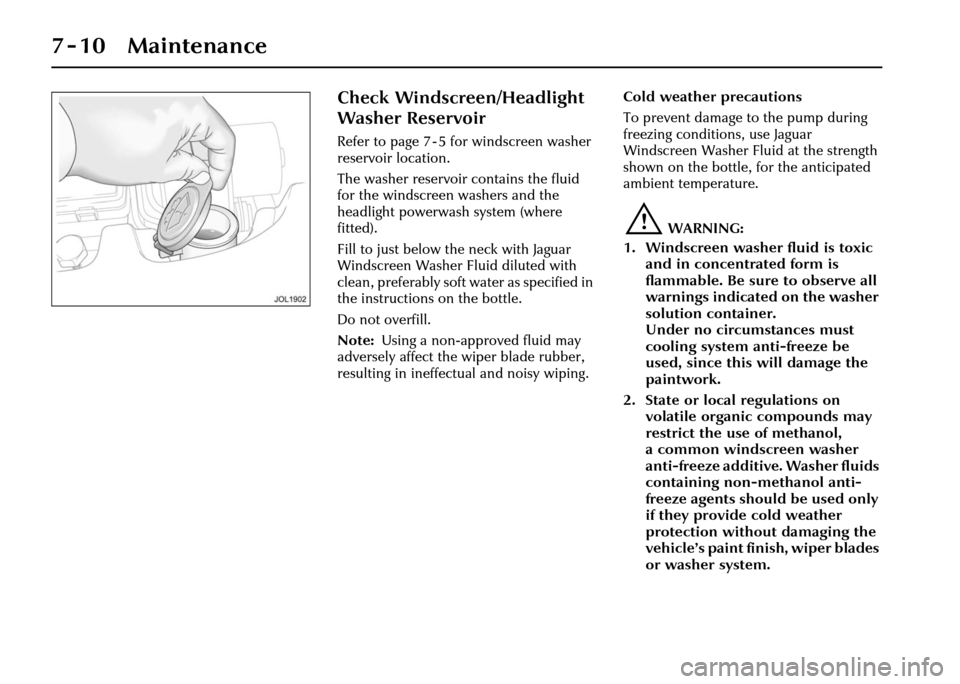
7-10 Maintenance
Check Windscreen/Headlight
Washer Reservoir
Refer to page 7 - 5 for windscreen washer
reservoir location.
The washer reservoir contains the fluid
for the windscreen washers and the
headlight powerwash system (where
fitted).
Fill to just below th e neck with Jaguar
Windscreen Washer Fl uid diluted with
clean, preferably soft water as specified in
the instructions on the bottle.
Do not overfill.
Note: Using a non-approved fluid may
adversely affect the wiper blade rubber,
resulting in ineffectual and noisy wiping. Cold weather precautions
To prevent damage to the pump during
freezing conditions, use Jaguar
Windscreen Washer Fluid at the strength
shown on the bottle, for the anticipated
ambient temperature.
!WARNING:
1. Windscreen washer fluid is toxic and in concentrated form is
flammable. Be sure to observe all
warnings indicated on the washer
solution container.
Under no circumstances must
cooling system anti-freeze be
used, since this will damage the
paintwork.
2. State or local regulations on volatile organic compounds may
restrict the use of methanol,
a common windscreen washer
anti-freeze additive. Washer fluids
containing non-methanol anti-
freeze agents should be used only
if they provide cold weather
protection without damaging the
vehicle’s paint finish, wiper blades
or washer system.
Page 194 of 227
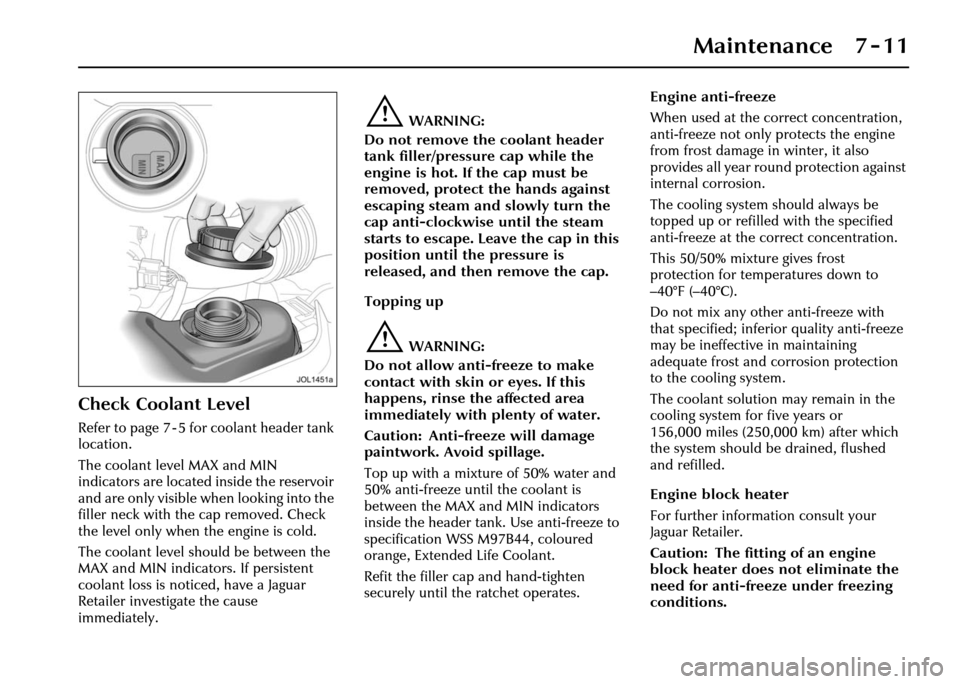
Maintenance 7 - 11
Check Coolant Level
Refer to page 7 - 5 for coolant header tank
location.
The coolant level MAX and MIN
indicators are located inside the reservoir
and are only visible when looking into the
filler neck with the cap removed. Check
the level only when the engine is cold.
The coolant level shou ld be between the
MAX and MIN indicators. If persistent
coolant loss is noticed, have a Jaguar
Retailer investigate the cause
immediately.
!WARNING:
Do not remove the coolant header
tank filler/pressure cap while the
engine is hot. If the cap must be
removed, protect the hands against
escaping steam and slowly turn the
cap anti-clockwise until the steam
starts to escape. Leave the cap in this
position until the pressure is
released, and then remove the cap.
Topping up
!WARNING:
Do not allow anti-freeze to make
contact with skin or eyes. If this
happens, rinse the affected area
immediately with plenty of water.
Caution: Anti-freeze will damage
paintwork. Avoid spillage.
Top up with a mixture of 50% water and
50% anti-freeze until the coolant is
between the MAX and MIN indicators
inside the header tank. Use anti-freeze to
specification WSS M97B44, coloured
orange, Extended Life Coolant.
Refit the filler cap and hand-tighten
securely until the ratchet operates. Engine anti-freeze
When used at the correct concentration,
anti-freeze not only protects the engine
from frost damage in winter, it also
provides all year round protection against
internal corrosion.
The cooling system should always be
topped up or refilled with the specified
anti-freeze at the correct concentration.
This 50/50% mixture gives frost
protection for temperatures down to
–40°F (–40°C).
Do not mix any other anti-freeze with
that specified; inferior quality anti-freeze
may be ineffective in maintaining
adequate frost and corrosion protection
to the cooling system.
The coolant solution
may remain in the
cooling system for five years or
156,000 miles (250,000 km) after which
the system should be drained, flushed
and refilled.
Engine block heater
For further information consult your
Jaguar Retailer.
Caution: The fitting of an engine
block heater does not eliminate the
need for anti-freeze under freezing
conditions.
Page 195 of 227
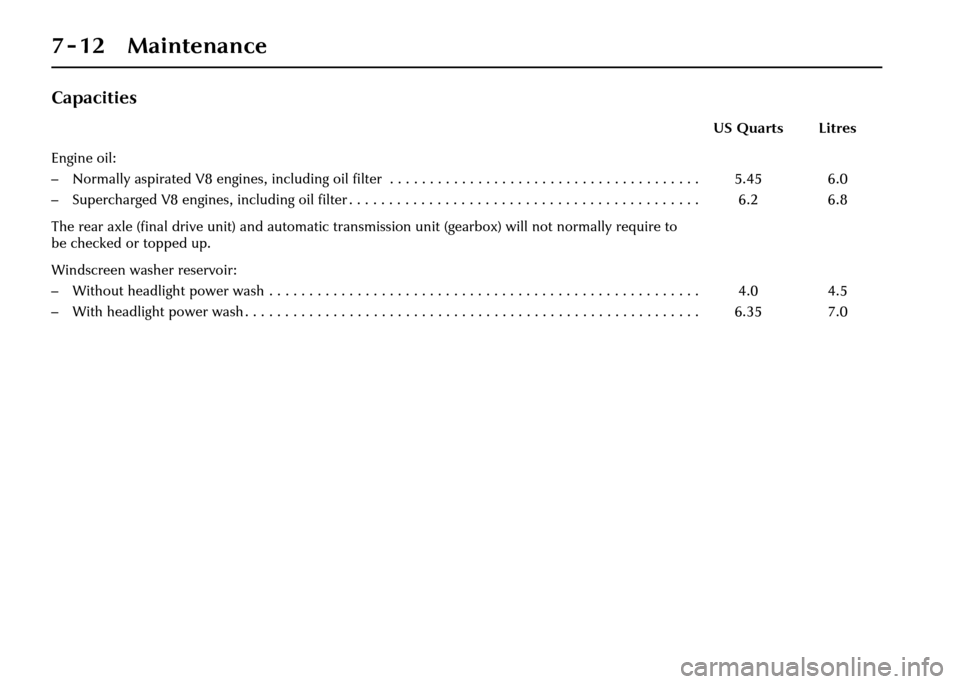
7-12 Maintenance
Capacities
US Quarts Litres
Engine oil:
– Normally aspirated V8 engines, including oil filter . . . . . . . . . . . . . . . . . . . . . . . . . . . . . . . . . . . . . . .
– Supercharged V8 engines, including oil filter . . . . . . . . . . . . . . . . . . . . . . . . . . . . . . . . . . . . . . . . . . . . 5.45
6.2 6.0
6.8
The rear axle (final drive unit) and automatic transmission unit (gearbox) will not normally require to
be checked or topped up.
Windscreen washer reservoir:
– Without headlight power wash . . . . . . . . . . . . . . . . . . . . . . . . . . . . . . . . . . . . . . . . . . . . . . . . . . . . . .
– With headlight power wash . . . . . . . . . . . . . . . . . . . . . . . . . . . . . . . . . . . . . . . . . . . . . . . . . . . . . . . . . 4.0
6.35 4.5
7.0
Page 196 of 227
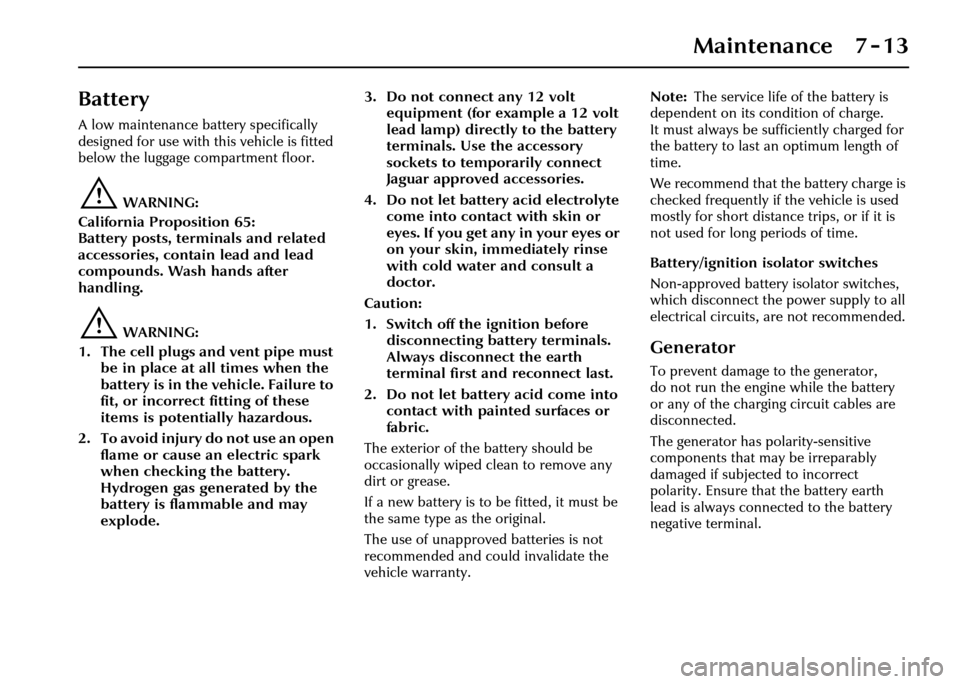
Maintenance 7 - 13
Battery
A low maintenance battery specifically
designed for use with this vehicle is fitted
below the luggage compartment floor.
!WARNING:
California Proposition 65:
Battery posts, terminals and related
accessories, contain lead and lead
compounds. Wash hands after
handling.
!WARNING:
1. The cell plugs and vent pipe must
be in place at all times when the
battery is in the vehicle. Failure to
fit, or incorrect fitting of these
items is potentially hazardous.
2. To avoid injury do not use an open flame or cause an electric spark
when checking the battery.
Hydrogen gas generated by the
battery is flammable and may
explode. 3. Do not connect any 12 volt
equipment (for example a 12 volt
lead lamp) directly to the battery
terminals. Use the accessory
sockets to temporarily connect
Jaguar approved accessories.
4. Do not let battery acid electrolyte come into contact with skin or
eyes. If you get any in your eyes or
on your skin, immediately rinse
with cold water and consult a
doctor.
Caution:
1. Switch off the ignition before disconnecting battery terminals.
Always disconnect the earth
terminal first and reconnect last.
2. Do not let battery acid come into contact with painted surfaces or
fabric.
The exterior of the battery should be
occasionally wiped clean to remove any
dirt or grease.
If a new battery is to be fitted, it must be
the same type as the original.
The use of unapproved batteries is not
recommended and coul d invalidate the
vehicle warranty. Note:
The service life of the battery is
dependent on its condition of charge.
It must always be sufficiently charged for
the battery to last an optimum length of
time.
We recommend that the battery charge is
checked frequently if the vehicle is used
mostly for short distance trips, or if it is
not used for long periods of time.
Battery/ignition isolator switches
Non-approved battery isolator switches,
which disconnect the power supply to all
electrical circuits, are not recommended.
Generator
To prevent damage to the generator,
do not run the engine while the battery
or any of the charging circuit cables are
disconnected.
The generator has polarity-sensitive
components that may be irreparably
damaged if subjected to incorrect
polarity. Ensure that the battery earth
lead is always connected to the battery
negative terminal.
Page 197 of 227
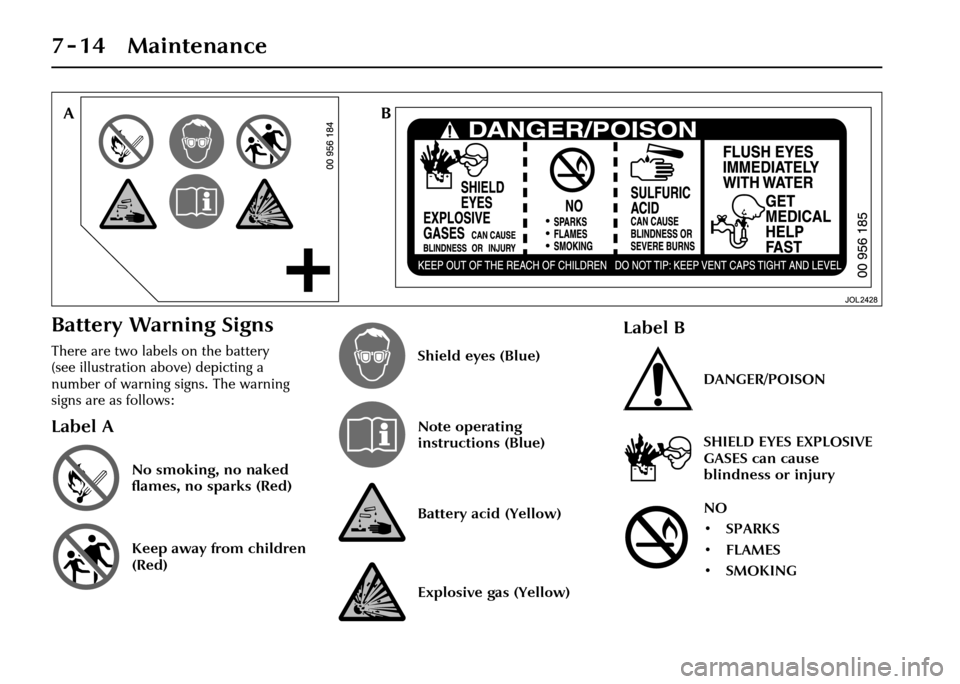
7-14 Maintenance
Battery Warning Signs
There are two labels on the battery
(see illustration above) depicting a
number of warning signs. The warning
signs are as follows:
Label A
No smoking, no naked
flames, no sparks (Red)
Keep away from children
(Red)
Shield eyes (Blue)
Note operating
instructions (Blue)
Battery acid (Yellow)
Explosive gas (Yellow)
Label B
DANGER/POISON
SHIELD EYES EXPLOSIVE
GASES can cause
blindness or injury
NO
•SPARKS
•FLAMES
•SMOKING
Page 198 of 227
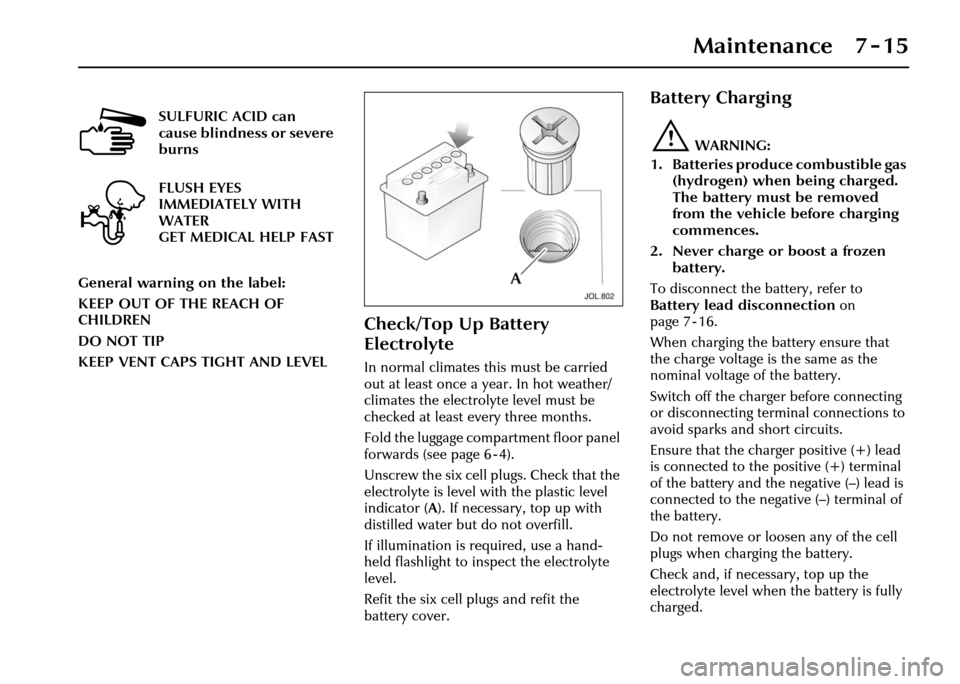
Maintenance 7 - 15
Check/Top Up Battery
Electrolyte
In normal climates this must be carried
out at least once a year. In hot weather/
climates the electrolyte level must be
checked at least every three months.
Fold the luggage compartment floor panel
forwards (see page 6 - 4).
Unscrew the six cell plugs. Check that the
electrolyte is level wi th the plastic level
indicator ( A). If necessary, top up with
distilled water but do not overfill.
If illumination is required, use a hand-
held flashlight to in spect the electrolyte
level.
Refit the six cell plugs and refit the
battery cover.
Battery Charging
!WARNING:
1. Batteries produce combustible gas (hydrogen) when being charged.
The battery must be removed
from the vehicle before charging
commences.
2. Never charge or boost a frozen battery.
To disconnect the battery, refer to
Battery lead disconnection on
page 7 - 16.
When charging the battery ensure that
the charge voltage is the same as the
nominal voltage of the battery.
Switch off the charge r before connecting
or disconnecting terminal connections to
avoid sparks and short circuits.
Ensure that the charger positive (+) lead
is connected to the positive (+) terminal
of the battery and the negative (–) lead is
connected to the nega tive (–) terminal of
the battery.
Do not remove or loosen any of the cell
plugs when charging the battery.
Check and, if necessary, top up the
electrolyte level when the battery is fully
charged.
SULFURIC ACID can
cause blindness or severe
burns
FLUSH EYES
IMMEDIATELY WITH
WATER
GET MEDICAL HELP FAST
General warning on the label:
KEEP OUT OF THE REACH OF
CHILDREN
DO NOT TIP
KEEP VENT CAPS TIGHT AND LEVEL
Page 199 of 227
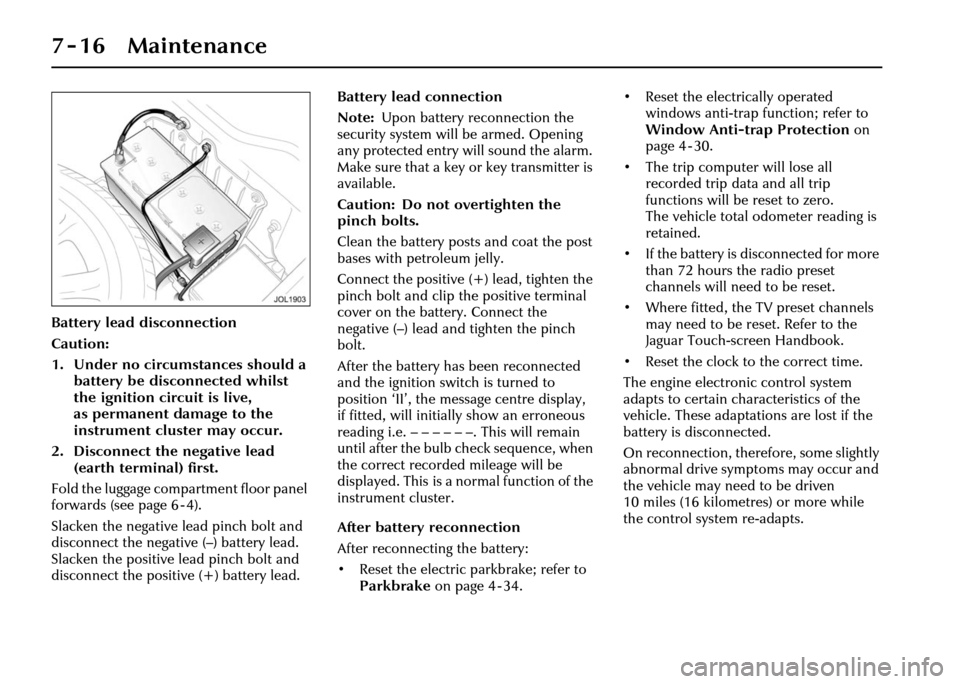
7-16 Maintenance
Battery lead disconnection
Caution:
1. Under no circumstances should a battery be discon nected whilst
the ignition circuit is live,
as permanent damage to the
instrument cluster may occur.
2. Disconnect the negative lead (earth terminal) first.
Fold the luggage compartment floor panel
forwards (see page 6 - 4).
Slacken the negative lead pinch bolt and
disconnect the negative (–) battery lead.
Slacken the positive lead pinch bolt and
disconnect the positive (+) battery lead. Battery lead connection
Note:
Upon battery reconnection the
security system will be armed. Opening
any protected entry will sound the alarm.
Make sure that a key or key transmitter is
available.
Caution: Do not overtighten the
pinch bolts.
Clean the battery posts and coat the post
bases with petroleum jelly.
Connect the positive (+) lead, tighten the
pinch bolt and clip the positive terminal
cover on the battery. Connect the
negative (–) lead and tighten the pinch
bolt.
After the battery ha s been reconnected
and the ignition swit ch is turned to
position ‘II’, the message centre display,
if fitted, will initially show an erroneous
reading i.e.––––––. Thiswill remain
until after the bulb check sequence, when
the correct recorded mileage will be
displayed. This is a normal function of the
instrument cluster.
After battery reconnection
After reconnecting the battery:
• Reset the electric parkbrake; refer to Parkbrake on page 4 - 34. • Reset the electrically operated
windows anti-trap function; refer to
Window Anti-trap Protection on
page 4 - 30.
• The trip computer will lose all recorded trip data and all trip
functions will be reset to zero.
The vehicle total odometer reading is
retained.
• If the battery is disconnected for more than 72 hours the radio preset
channels will need to be reset.
• Where fitted, the TV preset channels may need to be reset. Refer to the
Jaguar Touch-screen Handbook.
• Reset the clock to the correct time.
The engine electronic control system
adapts to certain characteristics of the
vehicle. These adaptations are lost if the
battery is disconnected.
On reconnection, therefore, some slightly
abnormal drive symptoms may occur and
the vehicle may need to be driven
10 miles (16 kilometres) or more while
the control system re-adapts.
Page 200 of 227
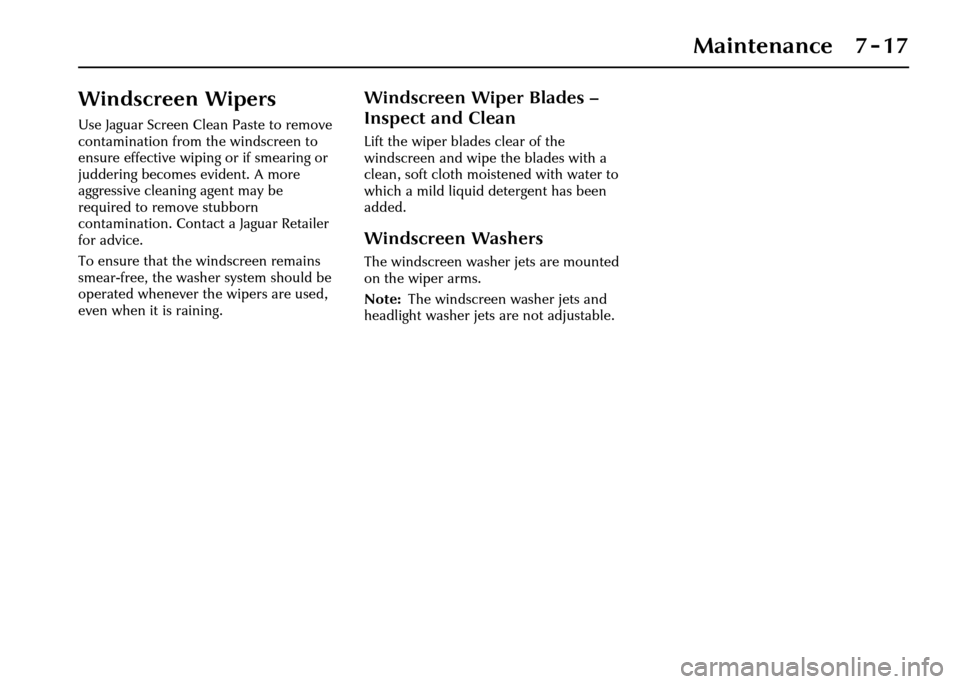
Maintenance 7 - 17
Windscreen Wipers
Use Jaguar Screen Clean Paste to remove
contamination from the windscreen to
ensure effective wiping or if smearing or
juddering becomes evident. A more
aggressive cleaning agent may be
required to remove stubborn
contamination. Contact a Jaguar Retailer
for advice.
To ensure that the windscreen remains
smear-free, the washer system should be
operated whenever the wipers are used,
even when it is raining.
Windscreen Wiper Blades –
Inspect and Clean
Lift the wiper blades clear of the
windscreen and wipe the blades with a
clean, soft cloth moistened with water to
which a mild liquid detergent has been
added.
Windscreen Washers
The windscreen washer jets are mounted
on the wiper arms.
Note:The windscreen washer jets and
headlight washer jets are not adjustable.